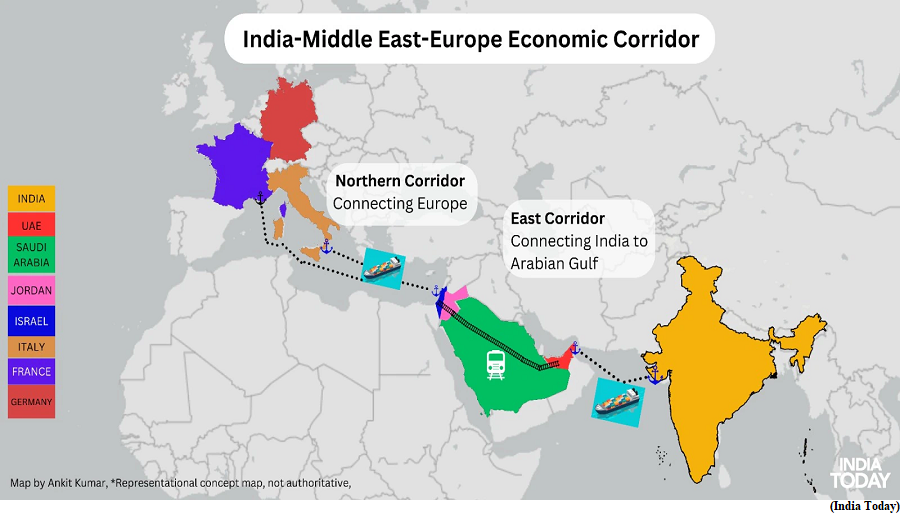How will Middle East corridor impact trade? (GS Paper 3, Economy)

Why in news?
- At a special event on the sidelines of the G-20 summit in New Delhi, a memorandum of understanding (MoU) was signed to establish the ‘India-Middle East-Europe Economic Corridor’ (IMEC).
- Other than the two co-chairs of the event, Indian Prime Minister and U.S. President, the signatories included leaders of Saudi Arabia, the UAE, the European Union (EU), Italy, France and Germany.
- The project forms part of the Partnership for Global Infrastructure and Investment (PGII).
What is the corridor?
- The proposed IMEC will consist of railroad, ship-to-rail networks (road and sea) and road transport routes (and networks) extending across two corridors.
- While the east corridor will connect India to the Gulf, the northern corridor will connect the Gulf to Europe.
- As per the MoU, the railway, upon completion, would provide a “reliable and cost-effective cross-border ship-to-rail transit network to supplement existing maritime and road transports routes”.
Significance:
- It would enable the transportation of goods and services from India to the UAE, Saudi Arabia, Jordan, Israel and Europe, and back.
- The corridor is expected to increase efficiency (relating to transit), reduce costs, generate jobs, and lower greenhouse gas emissions. This in turn will translate into a “transformative integration of Asia, Europe and the Middle East.”
- The MoU states that participants intend to enable the laying of cables for electricity and digital connectivity, as well as pipes for clean hydrogen export along the railway route.
- The MoU points out that participants will “work collectively and expeditiously” to arrange and implement all elements of the transit route. These relate to technical design, financing, legal and relevant regulatory standards.
- A meeting is planned in the next 60 days to carve out an “action plan” with “relevant timetables”.
How has it been received?
- India suggested the corridor “promises to be a beacon of cooperation, innovation, and shared progress,” Ursula von der Leyen, President of the European Commission, said the corridor was “more than ‘just’ a railway or a cable, it is a green and digital bridge across continents and civilisations.”
- EU called it the “most direct connection” between India, the Gulf and Europe: with a rail link that would make trade between India and Europe 40% faster.
- On the other hand, with the corridor being suggested as a competitor for China’s Belt and Road Initiative (BRI), the Chinese experts have doubts over pledges made by the U.S.
What geopolitics is at play here?
- It has often been believed that China is utilising the BRI from the Indo-Pacific to West Asia to further their economic and political influence, particularly on sovereigns with relatively unstable economies.
- For the U.S., the project could also serve to counter China’s influence at a time when America’s traditional Arab partners, including the UAE and Saudi Arabia, are deepening ties with China, India and other Asian powers.
What it holds for India?
- A corridor connecting India to Europe via West Asia and the Mediterranean region could serve as an “alternative trans-regional commercial transportation route” to the troubled Chabahar-based International North-South Transit Corridor.
- From Mumbai, Indian goods shipped by this route could arrive on the European mainland in as less as 10 days, 40% faster than through the Suez Canal maritime route.
- India’s “careful cultivation” of a multilateral economic cooperation with such a corridor “was of paramount importance.”
- Despite India’s favourable demographics, geography and commercial transportation infrastructure are not alone sufficient to ensure that India will realise its potential as a Eurasian economic power.
- The commercial corridors only emerge where requisite large investments in port and rail infrastructure are coupled with an industrial base anchored in manufacturing value chains”— precisely the purpose of the present corridor.
How does this affect Israel and Gulf ties?
- Saudi Arabia and Israel do not have diplomatic ties primarily because of differences of opinion about the Israel-Palestine conflict. In fact, Israel has official ties only with Egypt, Jordan, the UAE, Bahrain and Morocco in the Arab region. In this light, the transit network which seeks integration on multiple fronts assumes particular significance.
- The corridor’s passage through Jordan and Israel could also support the U.S. administration’s effort to build on the recent normalisation of ties between Israel and several Arab states, including the UAE. This may push Saudi Arabia to follow suit and formalise ties.
- With Saudi Arabia being the world’s top exporter of oil and the UAE being West Asia’s dominant finance centre, both are “seeking to project themselves as key logistics and trade hubs between east and west.”


